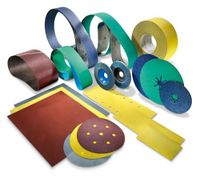Abrasives: Difference between revisions
From DT Online
m (Changed links) |
m (Added single quotes) |
||
| Line 9: | Line 9: | ||
|- | |- | ||
|'''[[Wet or Dry Paper|Silicon Carbide]]''' | |'''[[Wet or Dry Paper|Silicon Carbide]]''' | ||
| - commonly known as '' | | - commonly known as ''‘wet or dry paper’'' and used for general finishing of metals and plastics | ||
|- | |- | ||
|'''[[Emery Cloth]]''' | |'''[[Emery Cloth]]''' | ||
Revision as of 22:45, 27 October 2014
Abrasive papers and cloths are used for finishing wood metal and plastics. Various abrasive grits, including emery, garnet, sandstone, glass powder and silicon carbide, are graded by passing through sieves. The grit size is given as the sieve mesh size per inch - low numbers for coarse and high for fine.
Commonly used types are:
| Sandpaper, Glasspaper and Garnet papers | - used dry mainly for sanding of wood or coarse grades used for paint removal. |
| Silicon Carbide | - commonly known as ‘wet or dry paper’ and used for general finishing of metals and plastics |
| Emery Cloth | - used dry principally to polish metals - especially steel. |
Fine Steel Wool can also be used to produce a finish on metals or loaded with beeswax to cut back varnish on wood. Liquid cutting compounds and metal polishes are also mild abrasives, as are Pumice and Jewellers' Rouge.
Flap Wheels and Flap Discs comprise multiple overlapping small pieces or flaps and are used for metal finishing.
